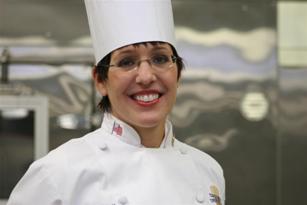Building Vegetarian Entrées
By Jackie Schulz
 Create protein combinations that are low in saturated fat, high in fiber and from a mix of sources to get a “complete” protein.
Create protein combinations that are low in saturated fat, high in fiber and from a mix of sources to get a “complete” protein.
According to a 2008 “Vegetarianism in America” study collected by the Harris Interactive Service Bureau and published by the Vegetarian Times, 3.2% of U.S. adults, or 7.3 million people, follow a vegetarian-based diet. Another 10% described their diet as “mostly vegetarian,” making them, in today’s lexicon, a “flexitarian”—those who follow a vegetarian diet some of the time. That prevalence makes having vegetarian options a necessity in any foodservice venue.

 Not that long ago, the idea of menuing local, seasonal ingredients was regarded as “stupid.” Now, more and more chefs are following the lead of this pioneer.
Not that long ago, the idea of menuing local, seasonal ingredients was regarded as “stupid.” Now, more and more chefs are following the lead of this pioneer. Providing clear information about how students will be evaluated helps them demonstrate their knowledge and skills as well as to evaluate themselves and others.
Providing clear information about how students will be evaluated helps them demonstrate their knowledge and skills as well as to evaluate themselves and others. Why is something so beneficial often overlooked? Encourage your students to develop their own service philosophies that they can use as a guide in their careers.
Why is something so beneficial often overlooked? Encourage your students to develop their own service philosophies that they can use as a guide in their careers. Step-by-step instructions show the best procedures for maximum yield and most attractive presentation.
Step-by-step instructions show the best procedures for maximum yield and most attractive presentation. Dr. Tim Ryan, CMC, president of The Culinary Institute of America (CIA), is a new member of the James Beard Foundation's Who's Who of Food & Beverage in America. The Beard Foundation announced Ryan as one of six "Who's Who" honorees for 2010 on March 22. They will be officially inducted during the Beard Foundation's annual awards gala in New York City on Monday, May 3.
Dr. Tim Ryan, CMC, president of The Culinary Institute of America (CIA), is a new member of the James Beard Foundation's Who's Who of Food & Beverage in America. The Beard Foundation announced Ryan as one of six "Who's Who" honorees for 2010 on March 22. They will be officially inducted during the Beard Foundation's annual awards gala in New York City on Monday, May 3. Mike Artlip, CEC, CCE, director of The School of Culinary Arts at Kendall College, was recently chosen by the state office team and board of directors of the Illinois Association of Family, Career and Community Leaders of America (FCCLA) to receive an honorary membership.
Mike Artlip, CEC, CCE, director of The School of Culinary Arts at Kendall College, was recently chosen by the state office team and board of directors of the Illinois Association of Family, Career and Community Leaders of America (FCCLA) to receive an honorary membership. Mary Petersen, founder and executive director of the Center for the Advancement of Foodservice Education (CAFÉ), has been named Chef Educator of the Year in the 2009-2010 Cordon d’Or - Gold Ribbon Annual International “Cookbooks & Culinary Arts” Culinary Academy Awards.
Mary Petersen, founder and executive director of the Center for the Advancement of Foodservice Education (CAFÉ), has been named Chef Educator of the Year in the 2009-2010 Cordon d’Or - Gold Ribbon Annual International “Cookbooks & Culinary Arts” Culinary Academy Awards. Delmar, part of Cengage Learning and a leading provider of learning solutions for ongoing career development and education, announces the March 2010 release of Modern Food Service Purchasing: Business Essentials to Procurement, a resource guide by award-winning author Robert Garlough of The Secchia Institute for Culinary Education at Grand Rapids Community College in Michigan.
Delmar, part of Cengage Learning and a leading provider of learning solutions for ongoing career development and education, announces the March 2010 release of Modern Food Service Purchasing: Business Essentials to Procurement, a resource guide by award-winning author Robert Garlough of The Secchia Institute for Culinary Education at Grand Rapids Community College in Michigan.